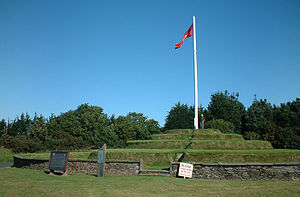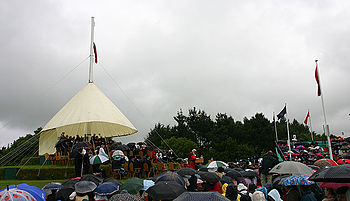Tynwald Hill: Difference between revisions
mNo edit summary |
|||
| Line 1: | Line 1: | ||
[[File:Tynwald | [[File:Tynwald tingvollen.jpg|right|thumb|300px|Tynwald Hill]] | ||
{{territory|Isle of Man}} | {{territory|Isle of Man}} | ||
'''Tynwald Hill''' is no more than a mound 12 feet high, and an artificial one at that, but it is at the heart of Manx culture and identity, for this is the ancient meeting place of the Tynwald; the ancient Manx parliament, and the place at which Tynwald still holds its ceremonial meetings each year on Tynwald Day. The hill is in the Parish of [[St John|St John, Isle of Man]]. | '''Tynwald Hill''' is no more than a mound 12 feet high, and an artificial one at that, but it is at the heart of Manx culture and identity, for this is the ancient meeting place of the Tynwald; the ancient Manx parliament, and the place at which Tynwald still holds its ceremonial meetings each year on Tynwald Day. The hill is in the Parish of [[St John|St John, Isle of Man]], and is said to be on the site of an ancient burial mound. | ||
Tynwald Hill is known in the Manx language as ''Cronk-y-Keeillown'', or the "Hill of the Church of John". The mound is said to include soil from all 17 of the Island's parishes. The mound includes four circular platforms, which are of successively decreasing size, thereby giving Tynwald Hill a somewhat conical shape. | Tynwald Hill is known in the Manx language as ''Cronk-y-Keeillown'', or the "Hill of the Church of John". The mound is said to include soil from all 17 of the Island's parishes. The mound includes four circular platforms, which are of successively decreasing size, thereby giving Tynwald Hill a somewhat conical shape. | ||
==Tynwald Day== | ==Tynwald Day== | ||
'''Tynwald Day''' is the National Day of the [[Isle of Man]], usually occurring on 5 July. On this day the Island's legislature, | [[File:Tynwald Day - geograph.org.uk - 24026.jpg|right|thumb|350px|Tynwald Day]] | ||
'''Tynwald Day''' is the National Day of the [[Isle of Man]], usually occurring on 5 July. On this day the Island's legislature, Tynwald, meets at [[St John's, Isle of Man|St John's]], instead of its usual meeting place in [[Douglas]]. The session is held in part in the Royal Chapel of St John the Baptist and partly in the open air on the adjacent Tynwald Hill. The first recorded such meeting was the Midsummer Court of 1417. | |||
The meeting is attended by members of the two branches of Tynwald: the House of Keys, and the Legislative Council. The Lieutenant Governor presides as the representative of The Queen, who is Lord of Mann, unless Her Majesty is present to preside in person or another member of the Royal Family as Her representative. | The meeting is attended by members of the two branches of Tynwald: the House of Keys, and the Legislative Council. The Lieutenant Governor presides as the representative of The Queen, who is Lord of Mann, unless Her Majesty is present to preside in person or another member of the Royal Family as Her representative. | ||
Latest revision as of 20:57, 19 July 2013

Tynwald Hill is no more than a mound 12 feet high, and an artificial one at that, but it is at the heart of Manx culture and identity, for this is the ancient meeting place of the Tynwald; the ancient Manx parliament, and the place at which Tynwald still holds its ceremonial meetings each year on Tynwald Day. The hill is in the Parish of St John, Isle of Man, and is said to be on the site of an ancient burial mound.
Tynwald Hill is known in the Manx language as Cronk-y-Keeillown, or the "Hill of the Church of John". The mound is said to include soil from all 17 of the Island's parishes. The mound includes four circular platforms, which are of successively decreasing size, thereby giving Tynwald Hill a somewhat conical shape.
Tynwald Day

Tynwald Day is the National Day of the Isle of Man, usually occurring on 5 July. On this day the Island's legislature, Tynwald, meets at St John's, instead of its usual meeting place in Douglas. The session is held in part in the Royal Chapel of St John the Baptist and partly in the open air on the adjacent Tynwald Hill. The first recorded such meeting was the Midsummer Court of 1417.
The meeting is attended by members of the two branches of Tynwald: the House of Keys, and the Legislative Council. The Lieutenant Governor presides as the representative of The Queen, who is Lord of Mann, unless Her Majesty is present to preside in person or another member of the Royal Family as Her representative.
All bills that have received the Royal Assent are promulgated on Tynwald Day and by law any Act of Tynwald which is not so promulgated within 18 months of passage ceases to have effect. Other proceedings include the presentation of petitions and the swearing in of certain public officials.
Since the first recorded Midsummer Court in 1417, Tynwald Day had been held on 24 June, the feast day of St John the Baptist and Midsummer's Day]], but in 1753 the introduction of the Gregorian Calendar intervened, and Tynwald resolved that "Midsummer Tynwald Court shall be holden and kept ... upon or according to the same natural Days upon or according to which the same should have been so kept or holden ... in case this Act had never been made." so Tynwald Day would remain on 24 June by the Julian Calendar, which was then 5 July by the Gregorian Calendar, though it has not moved from 5 July notwithstanding that two further days' difference between the calendars have intervened since 1753. If Tynwald Day occurs on a Saturday or Sunday, it is normally commemorated on the next Monday, as happened in 2008 and 2009.
History
The name "Tynwald" is Norse, from Þingvellir, meaning "Plains of the Thing" (in which "Thing" is an assembly or court). The most famous of these is the Icelandic Þingvellir, where the Alþing used to meet, but the same name is found scattered across the British Isles. The ceremony of proclaiming laws on Tynwald Hill is also Norse: in Iceland the Lögberg ('Law-Rock' or 'Law-Hill') was used for the same purpose. The origins of the man-made Tynwald Hill are unclear, but it existed by the end of the 14th century. It was used in 1393 for the inauguration of Sir William le Scrope, and again in 1408 for the inauguration of Sir John Stanley, as Lords of Mann. Its first recorded use for the promulgation of laws dates to 24 June 1417, when Sir John Stanley presided.
Ceremony
The Lieutenant Governor, together with the Sword-Bearer and the officers and members of the Legislative Council, occupy the highest level of the Hill; officers and members of the House of Keys occupy the next level. Other officials are accommodated on the lower levels and at the foot of the mound. A tent covers the top platform. The flag of the Isle of Man flies from the flagpole except when the British Sovereign presides, when the Royal Standard flies.
After the God Save the Queen is sung, the First Deemster and Clerk of the Rolls, upon the instruction of the Lieutenant Governor, directs the Coroner of Glenfaba to "fence the Court". The coroner accomplishes the task by declaring, "I fence this Court of Tynwald in the name of our most gracious Sovereign Lady The Queen. I charge that no person do quarrel, brawl or make any disturbance and that all persons do answer to their names when called. I charge this audience to witness this Court is fenced. I charge this audience to witness this Court is fenced. I charge this whole audience to bear witness this Court is now fenced." Yn Lhaihder (the Reader) then repeats the same words in the Manx language.
After the Court is fenced, the coroners appointed for the coming year take the oath. The Coroners of the six sheadings ascend the Hill in order of precedence, commencing with the Coroner of Glenfaba, followed (in a clockwise direction around the Island) by the Coroner of Michael, the Coroner of Ayre, the Coroner of Garff, the Coroner of the Middle Sheading and the Coroner of Rushen. The First Deemster administers the oath to the kneeling coroners: "By that book and by the holy contents thereof and by the wonderful works that God hath miraculously wrought in heaven above and in the earth beneath in six days and seven nights, you shall, without respect of favour or friendship, love or gain, consanguinity or affinity, envy or malice, well and truly execute the office of coroner for each sheading to which you have been appointed for the ensuing year. So help you God." The Coroners then receive ceremonial staves from the Lieutenant Governor.
After the Coroners take the oath, the Lieutenant Governor states, "Learned deemsters, I exhort you to proclaim to the people in ancient form such laws as have been enacted during the past year and which have received the Royal Assent." Each law is promulgated by the First Deemster in English and by the Second Deemster in Manx. The deemsters state the title, and a brief description of the effects, of each act.
Once the deemsters promulgate the laws, individuals may present petitions for the redress of grievances. Petitions are presented at the foot of Tynwald Hill to the Clerk of Tynwald, who conveys them to the Lieutenant Governor. The petitions are then referred to a committee of Tynwald, then after the singing of the island's anthem all proceed off the hill to the Chapel.